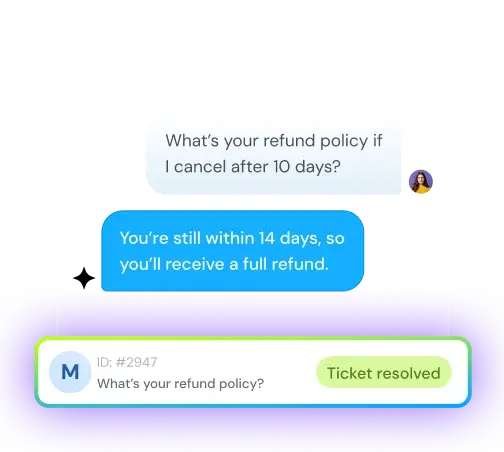Behind every ticket is a person—Customer empathy makes the difference
Sneha Arunachalam
Aug 18, 2025

What if the secret to better customer service isn’t faster replies or smarter tech — but simply understanding how people feel?
In today’s hyper-connected world, customers expect more than quick solutions — they expect to be heard, understood, and treated like humans, not ticket numbers. That’s where customer empathy steps in. It's more than just a buzzword; it’s a business strategy that builds trust, drives loyalty, and transforms support into a real relationship builder.
In this practical blog, we’ll break down what empathy really means in customer service, how to train your team to show it, the tech that can support it, and how top companies are doing it right. Whether you're leading a support team or refining your service approach, this guide will help you put customer empathy into action — and see real results.
Empathy as a skill: What it is and how to build it
Building empathy isn't something that happens overnight — but the payoff in customer relationships makes it worth the effort. Here's what makes this skill so powerful and how you can actually develop it in your service teams.
What is customer empathy?
Customer empathy is your ability to truly understand and connect with your customers' feelings. There's a big difference between sympathy — feeling sorry for someone — and empathy, which means actually putting yourself in their shoes. Real empathy is about connecting with their emotions and responding with genuine care.
You'll encounter two types:
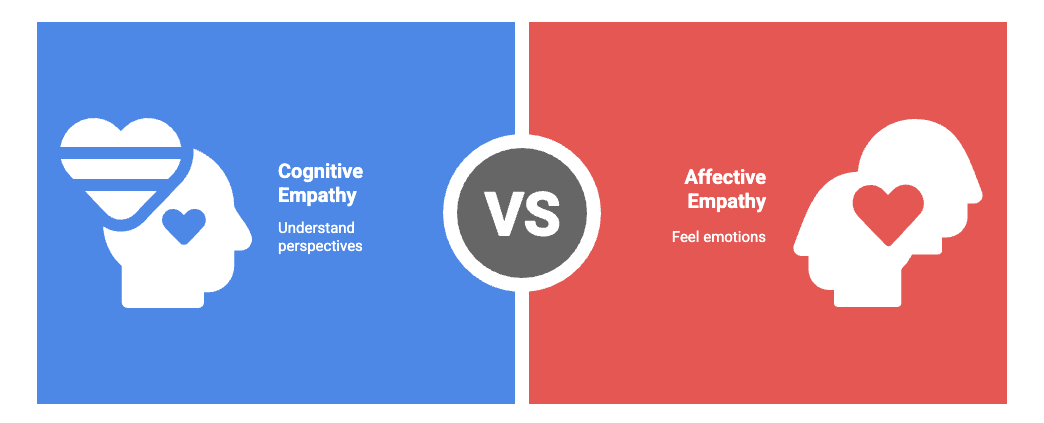
- Cognitive empathy - Understanding another person's perspective and seeing situations from their viewpoint
- Affective empathy - Actually feeling what others feel, creating an emotional connection
The business case is solid: customers will pay more for better experiences built on empathetic connections. Companies that get empathy right don't just satisfy customers — they create trust, build lasting relationships, and turn one-time buyers into lifelong advocates.
Emotional intelligence and self-awareness
Emotional intelligence forms the backbone of empathetic customer service. Daniel Goleman breaks this down into five categories in his book Emotional Intelligence: Why It Can Matter More than IQ — and they all impact how well your interactions go.
Self-awareness matters most for service reps. When you understand how your speech patterns, word choice, and tone affect people, you can adjust accordingly. It's pretty simple: manage your own emotions first, then you can better handle customer interactions.
Self-regulation comes next. Reps who master this can listen to complaints without getting defensive or making snap decisions. They stay cool under pressure and roll with whatever comes their way.
Here's where it gets practical: simple phrases like "I understand how frustrating this must be" can completely flip a difficult conversation. When you actively listen and respond genuinely, customers feel valued instead of processed.
Overcoming personal bias
Unconscious bias creates one of the biggest roadblocks to real empathy. Even with the best intentions, these automatic judgments shape how we interact with customers.
The research is eye-opening: an analysis of airline complaint responses on Twitter found that "African-American customers are less likely to receive responses to their complaints on social media". Customer satisfaction also dropped from 79% to 58% when call centers moved outside the U.S..
First step — admit these biases exist. They come from viewing situations only through your own experiences. Try these approaches:
Slow down when handling customer issues. Take a breath before responding to make sure your words reflect professionalism, not prejudice. Also, get input from team members with different backgrounds — their perspectives matter.
Companies like Zappos, Ritz-Carlton, and Alaska Airlines tackle bias by giving employees the power to make customer-focused decisions without jumping through approval hoops. This creates room for personalized, empathetic responses that go beyond assumptions.
Training your team for empathetic service
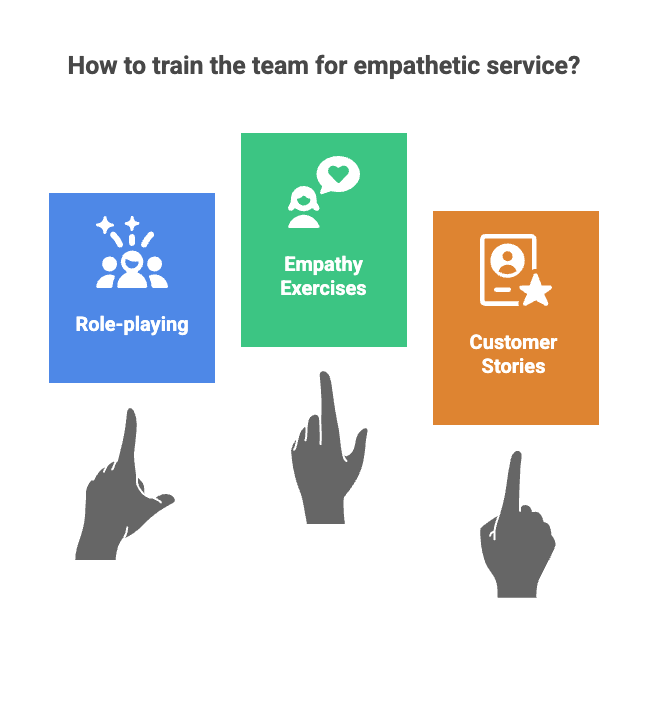
You can't just tell someone to "be more empathetic" and expect magic to happen. Real empathy takes practice — and the right kind of training makes all the difference. Education on active listening, perspective-taking, and emotional intelligence can significantly improve empathy skills in service representatives.
Role-playing and feedback loops
Think of role-playing like a flight simulator for customer service — it's where your team can crash and burn safely before they're handling real situations. Pair your team members for realistic scenarios, with one acting as a frustrated customer and the other as a support representative.
Focus on teaching representatives to:
- Restate and summarize what customers say
- Ask open-ended questions to understand concerns better
- Validate the customer's perspective
- Use appropriate body language and facial expressions
The real magic happens in the feedback afterward. After each role-play, dig into what worked and what felt off. This collaborative approach builds stronger muscle memory for handling tough service scenarios. That level of preparation becomes especially critical when handling angry or frustrated customers, as even small missteps can escalate conflicts.
Empathy exercises and workshops
Here are some exercises that actually work to strengthen your team's empathy skills:
Try the "unreasonable request" defense drill — representatives must justify seemingly impossible customer demands. Sounds crazy, but it builds perspective-taking skills by forcing teams to find the reasonable story behind demanding requests.
Emotion mapping works too. Have representatives map what customers are thinking, feeling, seeing, and hearing at each touchpoint. This develops cognitive empathy — the ability to intellectually understand someone else's perspective.
Expert-led workshops provide both the theory and hands-on practice. An effective workshop typically includes empathy concepts introduction, case studies, personal story sharing, and interactive Q&A sessions.
Using real customer stories in training
Nothing beats real stories for teaching empathy. Encourage service representatives to share authentic customer interactions during team meetings. These stories help team members see actual situations where empathy made a difference.
Here's what works: have representatives share stories like "The Handwritten Note" — where someone didn't just process a replacement order but included a personalized apology note that deeply touched the customer.
End these storytelling sessions by discussing empathy's impact. These narratives serve as critical empathy training, creating human connections that motivate action at the individual decision-making level.
Technology that supports customer empathy in service
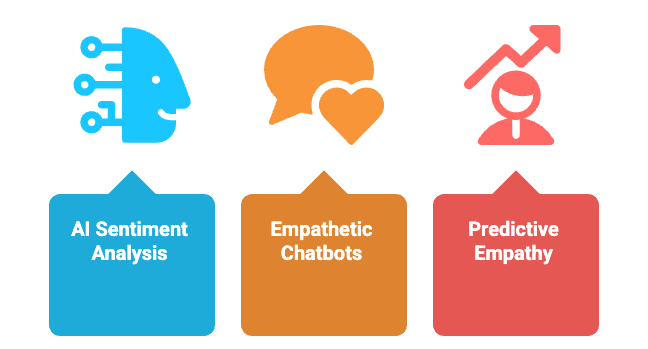
Technology actually makes it easier to connect with customers on an emotional level. Sure, human connection still matters most, but smart tools can help you understand and respond to customer feelings without losing that personal touch.
AI-powered sentiment analysis
These tools read between the lines of what customers are actually saying. They look at word choice, punctuation, even tone of voice to figure out if someone's happy, frustrated, or somewhere in between. It's like having a translator for emotions.
The real value? You can spot when someone's getting upset before they completely lose it. AI catches those warning signs during a call, so your team can switch gears before things go south. Since about 60-80% of customer inquiries are the same stuff over and over, this helps you focus on the interactions that really need a human touch.
What's cool is how these systems track emotional patterns across every touchpoint. You get a complete picture of how customers feel throughout their entire experience with you.
Empathetic chatbots with NLP
Forget those old chatbots that only understood specific keywords. These new ones actually get context and can pick up on what someone really means. They've gotten pretty good at detecting emotions and responding appropriately — what some people call "artificial empathy".
But timing matters. Customers love the emotional connection, except when they're in a hurry. Sometimes they just want their problem solved fast, and that's okay too.
Predictive empathy through data
This is where things get really smart. Customer Data Platforms work like empathy engines, pulling together information from everywhere to create a full picture of each customer. They can actually predict what someone might need before they ask for it.
Say your data shows a customer has been stuck on hold multiple times and has an ongoing billing issue. The system might flag them as likely to leave, so your team can reach out first with a solution.
The bottom line? Technology doesn't replace human empathy — it just makes it work better. These tools handle the routine stuff and give you emotional insights, so your people can focus on building real connections where they count most.
Embedding customer empathy into your service culture
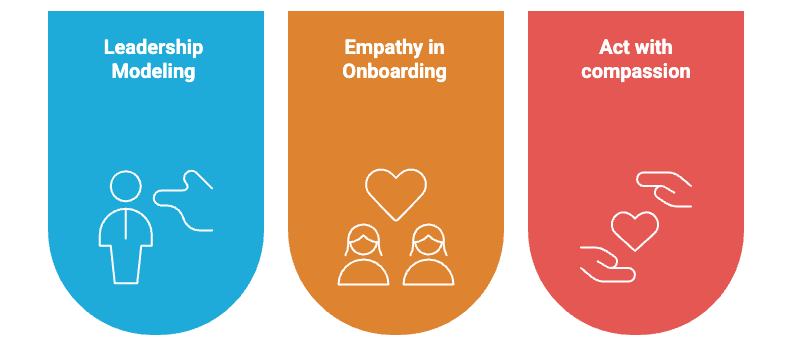
Building empathy skills is one thing — creating a culture where they actually matter is another challenge entirely. You can't just train a few people and call it done. Research shows that 90% of US workers believe empathetic leadership leads to higher job satisfaction, while 79% agree it decreases employee turnover. Your culture either supports empathy or kills it.
Leadership modeling empathy
Here's what we know: leaders set the tone for everything that happens below them. Studies reveal that empathetic leadership is positively related to job performance, especially among mid-level managers. When your executives actually demonstrate genuine understanding of customer needs, that behavior spreads throughout the company like wildfire.
Try these approaches that actually work:
- Visit customers in person or participate in focus groups
- Sit in on customer service calls regularly
- Make empathy a core value discussed in leadership meetings
- Recognize and reward empathetic behaviors
Organizations should explicitly let leaders know that empathy matters just as much as traditional task-oriented skills like monitoring and planning. Otherwise, it gets ignored when things get busy.
Empathy in onboarding and QA
First, incorporate empathy into your onboarding process with specific training modules. Second, evaluate conversations for markers of empathy in your QA programs. Finally, send post-interaction surveys asking if customers felt understood.
As one expert notes, "When evaluations are consistent and data-backed, agents feel recognized and supported". This approach reduces anxiety around performance reviews while building a stronger team environment.
Empowering agents to act with compassion
Empathy without action is just nice words. Importantly, 70% of employees consider empowerment critical to engagement. Giving your frontline staff authority to make decisions without endless approvals creates space for genuine empathetic responses.
Some companies empower agents to spend specified amounts to improve customer experiences. For instance, Ritz Carlton allows employees to spend up to $2,000 per incident to increase satisfaction. That's putting your money where your mouth is.
Empowered agents feel pride and ownership in their roles, which directly affects their interactions. Customers can sense when an agent is genuinely engaged — this builds a stronger, more authentic connection.
Measuring the impact of customer empathy
You can't improve what you don't measure — and empathy is no exception. The challenge is figuring out how to track something as human as emotional connection in a way that actually makes business sense.
Tracking emotional metrics
Smart companies now build empathy right into their Quality Assurance scorecards with markers like "acknowledges customer emotion" and "uses customer-focused language". This way, you can track empathy just like any other skill.
Some organizations have started using an "Empathy Index" that combines QA evaluations, sentiment analysis, and customer feedback into one unified metric. Think of it like a dashboard that shows how well your team connects emotionally with customers.
AI tools can now measure customer sentiment by analyzing voice pitch, volume, silence length, and keyword usage. These systems send real-time alerts to agents when empathy levels drop during a call, giving them a chance to adjust their approach on the spot.
Customer feedback and satisfaction surveys
Here's what's interesting: customer satisfaction scores jump higher when customers feel agents showed genuine empathy during calls. To capture this, companies use several survey approaches:
- Customer satisfaction (CSAT) surveys to baseline current empathy levels
- Net Promoter Score (NPS) to measure brand advocacy linked to emotional connection
- Customer effort surveys to identify pain points needing empathetic approaches
The real gold is in those verbatim comments. Phrases like "they really listened" or "I felt understood" tell you everything about whether your agents hit the mark. Numbers are great, but these stories show you what's actually working.
Linking empathy to business outcomes
The Harvard Business Review found that the top 10 companies in the Global Empathy Index increased in value more than twice as much as the bottom 10 and generated 50% more earnings. That's empathy directly impacting the bottom line.
Customers with emotional connections show 306% higher lifetime value and are way more likely to recommend brands to friends — 71% vs. 45% for those without that emotional attachment.
Empathy even improves First Contact Resolution. When customers feel emotionally safe, they share the full context upfront, helping agents solve problems faster. Since 96% of customers who experience high-effort interactions consider switching companies, this empathy-driven efficiency matters.
The tricky part is balancing subjective observation with customer perception. But when you get it right, you'll have insights that help build stronger relationships and deliver real business results.
Real world customer empathy examples
Some companies actually get this right — they've figured out how to turn empathy from a buzzword into something that genuinely helps their customers.
Allbirds: empathy through action
When COVID hit, Allbirds didn't just send out a generic "we're here for you" email. They created their "We're Better Together" campaign, letting customers buy Wool Runners for $60 instead of the usual $95 — and donate a second pair to healthcare workers.
But here's what's even better: they've donated over 225,000 pairs of shoes to Soles4Souls. Their Chief People Officer Laila Tarraf says empathetic leadership isn't about avoiding tough conversations — it's about having them with real compassion.
Zalando: emotional connection during crisis
Zalando's "We Will Hug Again" campaign hit different during the pandemic. Instead of pretending everything was normal, they acknowledged what everyone was feeling — isolated and disconnected. They used hugging as this universal symbol that everyone could relate to.
They also did the work behind the scenes. After researching with over 1,300 people in the disabled community, they created Adaptive Fashion collections. Turns out 20% of consumers with impairments had no idea where to shop for clothing that actually worked for them. That's empathy in action — seeing a real problem and actually solving it.
Conclusion
Here's what we know: customer empathy isn't some fluffy concept that sounds good in meetings — it's what separates thriving businesses from struggling ones.
We've covered the practical stuff. Your team can build these skills through role-playing and real customer stories. Technology can help by spotting emotional cues and predicting what customers need. Leaders who model empathy create cultures where it actually happens, not just gets talked about.
But here's the reality: customers aren't going to lower their expectations. They want to feel understood, valued, and respected. Businesses that ignore this emotional connection are basically choosing to fall behind.
You don't need to overhaul everything at once. Pick one thing from this blog and start there. Maybe it's listening more carefully during calls, or training your team differently, or just adding one empathy metric to track. Small changes create ripple effects that spread through your entire organization.
Your customers will notice the difference. So will your team. And your bottom line will thank you for it.
Quick summary: Customer empathy: The secret to better customer service
In today's hyper-connected world, customers expect more than quick solutions—they expect to be heard, understood, and treated like humans, not ticket numbers. Customer empathy isn't just a buzzword; it's a business strategy that builds trust, drives loyalty, and transforms support into a real relationship builder.
- Building empathy skills through role-playing, feedback loops, and real customer stories
- Technology integration with AI-powered sentiment analysis and empathetic chatbots that support human connection
- Cultural transformation where leadership models empathy and empowers agents to act with compassion
- Measurable impact with companies in the Global Empathy Index showing 50% more earnings than competitors
- Real-world examples from Allbirds and Zalando demonstrating empathy in action during challenging times
Customer empathy separates thriving businesses from struggling ones. Customers want to feel understood, valued, and respected—businesses that ignore this emotional connection choose to fall behind. Start small with one empathy initiative, and watch the ripple effects spread through your organization, improving customer relationships and your bottom line.
Frequently Asked Questions
Customer empathy means understanding your customer’s feelings, needs, and frustrations—and responding with care, patience, and support. It’s about seeing things from their point of view.
The 4 A's of Customer Empathy are a simple framework to help support teams practice empathy consistently and effectively. They stand for:
1. Acknowledge
Recognize the customer’s feelings or frustration.
Let them know they’ve been heard. This sets a respectful and validating tone.
“I understand how frustrating that must be…”
2. Align
Show that you're on the customer’s side.
Express shared intent and understanding of their situation.
“I’d feel the same if I were in your place. Let’s fix this together.”
3. Assure
Let them know you're going to help.
Offer clarity, ownership, and a sense of confidence.
“I’m going to take care of this for you.”
4. Act
Follow through with a real solution.
Empathy without action is empty. Deliver on what you promised.
Resolve the issue or escalate it appropriately—and follow up if needed.
You can show empathy to a customer by:
- Listening actively – let them speak fully.
- Acknowledging their feelings – show you understand.
- Using kind, human language – be warm and sincere.
- Taking responsibility and acting fast – fix the issue and follow up.
Train support teams through role-playing real customer scenarios, active listening exercises, and feedback-based coaching. Encourage team members to understand customer emotions, not just resolve issues, and model empathetic language in responses.
